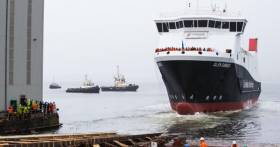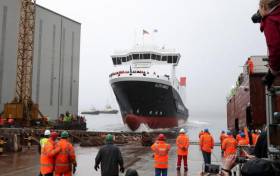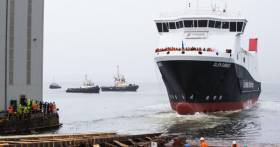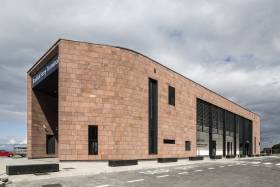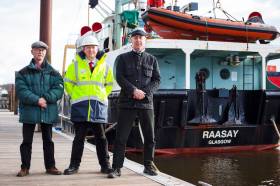Displaying items by tag: CalMac
On the Isle of Arran in Scotland, business owners have vented their fury over the loss of revenue and disruption to trade they say has been caused by the increasing unreliability of the island’s lifeline ferry service.
Islanders have told The Herald that a project which repositioned the harbour at Brodick, part of a £31 million investment to accommodate a new ferry for the Arran to Ardrossan route, has led to a spike in cancellations.
For more on this story on the Firth of Clyde route in south-west Scotland click here.
A second route albeit seasonal is based out of Ardrossan to Campbeltown on the Mull of Kintyre which Afloat featured in recent years.
Debut of Lifeline Ferries to Scotland's Islands Delayed Again Amidst Fears of Rising Costs
#ferries - A pair of long-awaited lifeline ferries to serve Scotland's island communities have been delayed indefinitely and it could add millions of pounds to the cost of the £97m project, a senior minister has revealed.
One of the ferries, MV Glenn Sannox - writes The Herald is destined for the Ardrossan-Arran route was due to enter service last summer but construction delays meant that was initially put back to this summer.
The second vessel, known as Hull 802, was supposed to be delivered to CalMac in the autumn of last year for use on the Uig-Lochmaddy-Tarbert triangle, and had then been due to be delivered in the Spring of next year.
It comes as it emerged as ferry builders Ferguson Marine Engineering Ltd (FMEL) and project overseers Caledonian Maritime Assets Ltd (CMAL) are involved in a contractual dispute over costs.
The new ‘dual fuel’ boats, which can use both diesel and liquified natural gas, are being built by Ferguson Marine Engineering Ltd, owned by Monaco-based billionaire Jim McColl, a member of the First Minister’s council of economic advisers.
And the Scottish Government has confirmed there has been a delay on even these delays. Click here for further reading on the story.
#FerryNews - A Scottish ferry company has been named 'Ferry Operator of the Year 2018' at an awards ceremony which was also open to entries from those serving ports in Ireland and the UK, writes Jehan Ashmore.
The winner, Calmac, which operates to the Scottish western isles was presented at the recently held National Transport Awards in London.
Those who entered needed to demonstrate how they have improved services and facilities over the year. This included results that have been achieved across performance and reliability, passenger growth, and customer satisfaction.
Commenting on the award, CalMac managing director, Robbie Drummond said, "This is an award for all our staff in recognition that no matter what challenges we face, whether it be extreme weather conditions or vessel availability, they will always provide the best possible service for our customers".
"Last year was another historical high for carryings. Overall in the five years to 2017, passenger numbers have gone up by 17% and vehicles by 37%".
Mr. Drummond added "Our core market is the lifeline services we provide to communities across the area we support, but the popularity of our services with visitors is growing year on year. This is a huge recognition that our people can continue to provide a first class customer experience in the face of booming numbers travelling with us"
ARRAN on Firth of Clyde - CalMac's most popular route
Among CalMac's extensive route network of 26 routes serving island and remote mainland locations is to the Isle of Arran on Firth of Clyde. The island dubbed as Scotland in miniature (see report) is near to the large population 'central belt' of Glasgow and Edinburgh and of the route network is the nearest to Northern Ireland.
The short-sea 55 minute route of Brodick-Arran,(new terminal opened this year) had the highest number of passengers with 844,198 travelling in 2017.
As the National reports, the figures were obtained by the local member of the Scottish parliament, Kate Forbes, MSP for Skye, Lochaber and Badenoch.
The next best performing routes was Largs to Millport (745,619), Wemyss Bay to Rothesay (713,906), Oban to Craignure (670,248) and Mallaig to Armadale (285,483).
The Scottish National Party (SNP) member however hit back at Labour's criticism of new CalMac ferry delays (click here) in addition to previous coverage on Afloat.
Last year, CalMac carried more than 5.3 million passengers, an increase of 300,000, and nearly 1.4 million vehicles.
For further reading on this story click, here.
Shipyard in Scotland Urged to Pay for Delay to Two New CalMac Ferries
#FerryNews - A ferry firm state-owned by the Scottish Government has insisted it will not pay any extra cash for two new car-ferries being built to serve Scotland’s island communities, despite the work running over time and over budget.
As The Nationalist writes, Caledonian Maritime Assets Ltd (CMAL), which is responsible for buying and leasing ferries for operators CalMac, revealed it had known for more than 15 months that “things were not going to plan” with the construction of the vessels.
The Ferguson Marine shipyard in Port Glasgow won the £97 million contract to build the ferries – which will be the first in the world to run on a dual fuel system using both diesel and liquefied natural gas. For further reading on the newspapars story, click here.
First of the newbuilds, Afloats adds, named Glen Sannox following a competition was launched earlier this year at the Clydeside shipyard. The pair are designed to provide a fully flexible year-round service for the Ardrossan-Arran Island service and the Uig Triangle.
Earlier this year a new terminal on Arran was opened in advance of this summer. Sailings are served by Caledonian Isles and during the high-season support came from the veteran Isle of Arran (see Afloat’s ferry voyage report).
The CalMac route on the Firth of Clyde is the most southerly 'year-round' operated service.
#FerryNews - A pair of ferries being built on the Clyde, Scotland for the publicly owned operator CalMac in a £100 million deal have been hit by new delays, the Scottish Government has confirmed.
As The National reports, the roll-on roll-off car and passenger vessels for the Clyde and Hebrides network are being built at Ferguson Marine Engineering at Port Glasgow.
The MV Glen Sannox, launched last year, was initially due to be delivered in May but was pushed back to this winter. Its completion date is now June 2019 and it is due to enter service on the Ardrossan-Arran (see new terminal) route around two months later, after sea trials.
For further reading on the delays to the newbuilds, click here.
#FerryNews - In south-west Scotland, the Arran Ferry Committee has urged the powers that be to keep the ferry travelling to Ardrossan during the planned upgrades at the Harbour.
The committee met on Monday, May 14 and numerous groups, businesses and stakeholders were present, including five Calmac representatives.
Last month the (Scottish) Herald exclusively revealed that Calmac wanted the ferry to move to Troon during harbour upgrades but none of the other members of the Ardrossan Harbour Taskforce shared this view, with local MSP Kenneth Gibson vehemently against the move.
On Monday’s, Mr Gibson made his opposition to any move clear and asked for the views of the committee and Calmac. None of the Calmac representatives said they knew enough about the Ardrossan Harbour redevelopment to give an opinion, although they said ‘safety came first.’
For more news on the Firth of Clyde ferry service, click here.
#FerryNews - Scottish ferry operator, Caledonian MacBrayne (CalMac) wants the Ardrossan to Brodick,Arran service to relocate to Troon during harbour upgrades, the Herald can exclusively reveal.
But stakeholders on the Ardrossan Harbour Taskforce are keen to see the ferry stay put, even when work is being carried out – with other locals saying that any move to Troon sets a dangerous precedent.
And at the height of the ‘Save Our Ferry’ campaign last year, the MV Isle of Arran struck the sea wall at Troon Harbour whilst attempting to seek refuge.
That put a huge dent in the ‘Choose Troon’ campaign from the businesses in the town and the port owners, ABP, Associated British Ports.
To read more on this development, click here and for related story on Calmac's ageing fleet
#FerryNews - Passengers may face delays and disruption this summer as Scottish operator, CalMac struggles to keep ageing ferries running.
As The National reports, the operator is preparing for what it believes will be its busiest tourist season on record.
However, interim managing director Robbie Drummond says older boats may struggle under the “strain”.
Last year more than five million people, almost 1.5 million cars and 80,000 coaches used the network.
Eight of CalMac’s 30-strong fleet have been sailing for more than three decades, with the average age of all carriers topping 20 years, and the company says problems with one ferry could create disruption on other routes.
Click link here and scroll down for more of the story.
Brand New Ferry Terminal Opens On Arran, Firth of Clyde
#FerryNews - The first passengers to use Scottish operator CalMac’s brand new ferry terminal on Isle of Arran, Firth of Clyde, became a reality on Tuesday with sailings operating to and from Ardrossan, writes Jehan Ashmore.
Ferry, Caledonian Isles made the inaugural berthing at the new terminal in Brodick, the island’s main town on the east coast. The terminal in Brodrick Bay is also a popular scenic anchorage for leisure craft that has included the schooner superyacht Eos.
The new facility, Afloat adds also incorporates a pier berth-linkspan to cater also for a new dual-fuel ferry powered by liquefied natural gas (LPG) and marine-gas oil (MGO).
The newbuild currently under construction, Glen Sannox (first of a pair) assigned to Arran route, was expected to enter service last summer on the busy short-sea route that takes just under an hour. Due to complex engineering works at the Fergusan Marine Engineering Ltd (FMEL), Port Glasgow, the new 102m ferry has been rescheduled with a debut expected in the second half of 2018.
The ferry terminal project as previously reported in 2016 (see photo) is Arran’s main ferryport and was completed by Caledonian Maritime Assets Limited (CMAL). The terminal which is an extensive upgrade of the facilities is to be officially opened with details to be released within weeks.
The other island terminal is at Lochranza from where the shorter ferry routes linking Claonaig and Tarbart albeit in the more remote Kintyre Peninsula as distinct to Ardrossan in Ayrshire.
CMAL adds the completion of the £30 million redevelopment project was unexpectedly delayed by an issue relating to the automated door closure on the passenger access system (PAS). The project was substantially complete in summer last year, but the PAS failed to receive its CE mark certification and could not be used. The issue has now been resolved and CE mark certification is in place.
The redevelopment project has completely transformed the terminal, delivering a new pier, an increased marshalling area through reclaimed land and a modern terminal building, with bus stances and parking facilities. It was CMAL’s single biggest port infrastructure construction project delivered.
In addition to CMAL’s role, the project was given support from Transport Scotland, North Ayrshire Council, Strathclyde Partnership for Transport and Coastal Communities Fund.
Career Ends for Last of Scottish ‘Island’ Class Ferry While Sisters Remain In Irish Service
#FerryNews – One of the longest serving car ferries of Scottish operator, CalMac, is retiring from west coast service, though a number of sisters remain in Irish waters, writes Jehan Ashmore.
The MV Raasay built to a landing craft design, whereby vehicle access was only available at the bow (incl. foot passengers) became the last of eight ‘Island’ class delivered during the 1970’s. The small ferry at 69grt served its namesake island located in the Inner Hebrides.
Several of the Island class sisters remain in service following disposal to new owners operating along the Irish western seaboard. These sisters, all beyond their 40th year, maintain island services off counties Donegal and Galway. Afloat will have more on these sisters, though the MV Canna which had served Rathlin Island off Antrim was disposed last year.
The 75 passenger / 6 vehicle MV Raasay served the Sconser-Raasay route for 21 years from the vessel's launch in 1976 until increased traffic from the island made her unsuitable. From hereon the ferry became one of the CalMac relief vessels until being pressed back into regular service again in 2003 as the winter ferry serving Kilchoan-Tobermory.
The 'Island' class vessels transformed services for CalMac, as they opened up a new route to Arran. In addition to opening two additional routes to Mull and provided a safe and reliable link from Skye to Raasay. Being virtually interchangeable they greatly increased the flexibility of the fleet.
CalMac which is state-owned under the Scottish Government, operates a fleet of 33 vessels serving 27 island and remote mainland communities across the west coast. They are the UK's largest ferry company and last year they carried more than 5.3 million passengers and nearly 1.3 million vehicles.
MV Raasay was handed back to owners Caledonian Maritime Assets Ltd (CMAL) who are expected to announce a buyer for the vessel shortly.


























